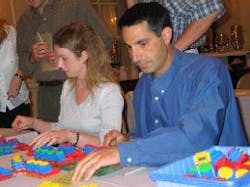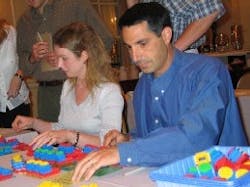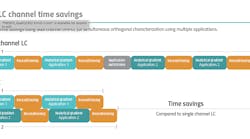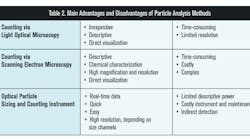2006 TOTY Finalist Profiles: Wyeth Excellence in Operations Team, Pearl River, N.Y.
Turning the Ship Around in Pearl River
| Editor's Note: To read the introduction to all five Team of the Year Finalists' stories and access links to the other teams' profiles, click here. |
Management had never said do or die, says Twomey-Galvin. But we decided that we would give ourselves one year to turn this situation around, she says.
A team of 16 people was established to lay the groundwork for streamlining and optimizing manufacturing and packaging operations, in an initiative called Excellence in Operations. The core group included planners, supervisors, department heads, Quality personnel and two consultants from Value Innovation Partners (Haverhill, Mass.), an operational improvement firm that espouses Lean Six Sigma practices.
Within three weeks, the team had constructed 14 value stream maps, which would help to analyze operations and spotlight wasteful or unproductive processes. Eight sub-teams were formed to address key process bottlenecks and issues that had the greatest impact on product reliability and cost:
- set-up time reduction (one team each for packaging, compression and coating);
- total productive maintenance (TPM) for compression and coating;
- demand and operations planning;
- packaging throughput and OEE;
- raw material quality variability;
- root cause analysis.
Members from all four of the sites core functional groups Manufacturing, Quality, Packaging and Technology were represented on the core team, and on each of the sub-teams. Leads and owners from the eight teams met weekly with Twomey-Galvin to coordinate and prioritize projects, and once a month with an executive steering committee. The teams were given few instructions other than that they all had blank slates to work with. No idea would be dismissed.
One year later, now that the initiatives first phase has been completed, Centrums manufacturing is altogether different:
- A pull manufacturing system has been instituted, resulting in significant reductions in inventory and other efficiencies. Manufacturing is paced according to a weekly packaging schedule.
- Centrum cycle time has been cut from 33 days to 11, well within reach of the organizations single-digit cycle time.
- Direct labor has been reduced by 24%, indirect labor by 11%, accounting for annualized savings of $4.6 million.
- The percentage of lines shipped complete stands at 98.9%, compared to 96.9% previously.
- Safety remains exceptional, with more than one million hours worked without a lost time or restricted work injury.
Theres a renewed sense of pride and optimism in Consumer Healthcare, which has carried over into Pearl Rivers R&D and Vaccines units as well. We want to be the premier site in the Wyeth network, says Andrew Espejo, director of Centrum manufacturing.
This has been a very difficult culture change for us, but everyone in the factory has embraced it with enthusiasm and a spirit of cooperation, adds Joe Vitanza, managing director of the Consumer Healthcare business. We know what we need to do, and we are pulling together as a team.
No one would have believed this a year ago, especially not the Centrum operators, who had worked an average of 22 years for the company. Were still struggling with changing the culture, Espejo says. Its a huge boat to turn around. But the momentum is there. Cassandra Coffman, senior manager of Continuous Improvement, has spearheaded the sites efforts to get the shop floor involved.
No flavor of the month
To overcome the doubters, Consumer Healthcares management made clear from the start that they were serious about change. They instructed each of the 70 or so members of the core team and sub-teams more than 50 of them from the shop floor to set aside four hours a day for 13 weeks to work on Excellence in Operations projects. No other meetings were to be scheduled during this time, and workers were expected to find ways of managing their day jobs while contributing to the project.
This was a little stressful in the beginning, says Farooq Moatter, director of Quality Assurance. But we had to make sure that people understood that the project wasnt just the flavor of the month.
Getting broad representation from the shop floor was critical. The team also relied heavily on metrics. In the beginning, the site tracked more than 50 KPIs some daily, others weekly and monthly. Some metrics have since been discontinued while others are added as areas of focus change. Ultimately, the site hopes to have a handful of key measures that will drive the business.
Operator input has been tremendously valuable, Twomey-Galvin adds. Not all answers need to come from a bunch of people with engineering degrees.
The Excellence in Operations program has been shaped by Lean Six Sigma, total productive maintenance (TPM), single minute exchange of dies (SMED), 5S and other critical tools of process excellence. But success has depended on letting the team drive change, rather than the tools. Theyre trying to drive the culture change based on feedback from the floor, says Moatter, not because management wants it.
Elements of Six Sigma, for example, have been rolled out gradually. To date, there are just two Black Belts and a few Green Belts on the team. Cara Muscolo, David Quinones and their teams developed the future state, which also drove many of the changes. Control charts, spaghetti diagrams and other Six Sigma tools are applied as needed.
5S has been implemented similarly in pockets, says Espejo. In the compression area, for example, operators and team members set up designated locations for the washing, cleaning and storage of compression turrets, and purchased new tools, toolboxes and storage carts for maintenance. We did this without really calling it 5S, says Espejo.
Quick wins
Plucking the low-hanging fruit helped build momentum for the program. For years, tablet compression had been the main bottleneck, and the largest challenge in operations. Making headway in this area would get the ball rolling.
Five years ago, the Centrum lines had switched from slow, low-tech machines to high-speed Fette tablet presses. Maintenance issues ensued. There was limited in-depth knowledge of the Fette tablet presses. Any time there were significant issues with the presses, Fette technicians were called to the site.
The TPM team initiated a compression maintenance program. It embraced the already installed MRO Software (Bedford, Mass.) Maximo Maintenance Management System, and required all workers to take Fettes four-level training program. The result: few if any breakdowns, and all maintenance done by in-house operations staff.
Tooling changes on the presses that used to take 12 to 16 hours are now done in four, thanks to collaboration by the TPM and SMED teams.
Improving yourself out of a job?
There was concern that a leaner, nimbler organization all around would mean that fewer staff would be needed. The upside is that all of the operators on the floor have been given a voice. A recent project, led by Walter Wardrop, director of packaging and planning, has been to place white boards in all key functional areas for employees to promote their ideas for change. The boards have gotten so much use that some areas now have several, and the Excellence in Operations team is now looking into how to better manage and process the torrent of ideas.
Before the idea boards, I used to ask, Why? a lot, says former set-up worker Rock. Our only outlet was to talk to our direct supervisor, but now we can share ideas with the whole team. Rocks good ideas, in fact, are the main reason that hes now a production supervisor.






